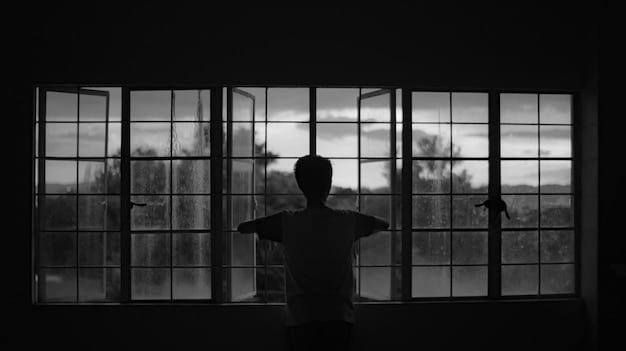The Art of Vulnerability: Strengthening Bonds Through Shared Fears

The art of vulnerability, by sharing deeply personal fears, serves as a powerful catalyst for enhancing emotional intimacy and forging stronger, more authentic bonds in any close relationship, fostering trust and mutual understanding.
In a world often presenting facades of strength and invulnerability, the true power of human connection often lies in its opposite: vulnerability. The Art of Vulnerability: How Sharing Your Fears Can Strengthen Your Bond explores this often-misunderstood concept, delving into how opening up about our deepest fears can transform relationships, fostering profound intimacy and unwavering trust.
Understanding Vulnerability: More Than Just Weakness
Vulnerability is frequently misconstrued as a sign of weakness, a state of being exposed or susceptible to harm. However, a deeper understanding reveals it as a courageous act of authenticity. It is the willingness to show up as we truly are, imperfections and all, knowing there’s no guarantee of the outcome.
This willingness to be seen, without pretense or protection, is fundamental to true connection. It’s about dropping the emotional shields we unconsciously carry, allowing another person to glimpse the less polished, more human parts of ourselves. Far from being a flaw, this capacity for openness is a cornerstone of genuine intimacy.
The Science Behind Connection
Neuroscience suggests that vulnerability triggers empathy and fosters a sense of shared humanity. When one person expresses vulnerability, it often activates mirror neurons in the other, creating a synchronous emotional experience. This mirroring effect builds bridges of understanding, making both individuals feel more connected and less alone in their experiences.
- Vulnerability activates empathy circuits.
- It lowers defenses and promotes openness.
- Sharing personal truths builds mutual respect.
- It creates a safe space for authentic interaction.
The act of being vulnerable also encourages reciprocity. When we share a part of ourselves, we implicitly invite the other person to do the same, creating a virtuous cycle of openness. This exchange is not about an even trade, but about a shared commitment to building a relationship founded on genuine understanding and acceptance. It shows trust, inviting trust in return.
Ultimately, vulnerability in relationships moves beyond superficial interactions to create a profound sense of belonging. It allows partners, friends, and family members to see each other as complex, multifaceted individuals, capable of both immense strength and tender fragility. This holistic view of one another is what truly cements lasting bonds.
The Fear Factor: Why We Hesitate to Share Our Fears
Despite the known benefits, sharing fears is often a daunting prospect. This hesitation stems from deeply ingrained psychological and social constructs. We are taught from a young age to project an image of strength and self-sufficiency, often equating fear with inadequacy or failure. This cultural conditioning can make admitting our fears feel like an admission of personal defeat.
Societal Expectations and Personal Insecurities
Societal norms frequently pressure individuals, particularly men, to suppress emotions deemed “weak,” including fear. This can lead to a pervasive sense of isolation, as individuals guard their true feelings for fear of judgment or rejection. The internal monologue often questions: “What will they think of me if they knew I was afraid of this?”
Beyond societal pressures, personal past experiences play a significant role. If previous attempts at vulnerability were met with dismissal, ridicule, or betrayal, the brain registers this as a threat, making future attempts exponentially more difficult. This protective mechanism, while understandable, can inadvertently hinder the formation of deeper connections.
- Fear of judgment and ridicule.
- Concern about appearing weak or incapable.
- Past negative experiences with shared vulnerability.
- The perceived loss of control or power.
Another major deterrent is the fear of burdening others. We often worry that sharing our anxieties will place an undue weight on the people we care about, making them uncomfortable or even driving them away. This self-sacrificing impulse, ironically, can prevent the very support and comfort we need.
Finally, there’s the intrinsic human discomfort with the unknown. When we share a fear, we surrender an element of control over how that information will be received and processed. This uncertainty can be paralyzing, leading us to avoid the discomfort by simply not sharing at all. Overcoming this “fear of fear” is crucial for authentic relational growth.

The Transformative Power of Shared Vulnerability in Relationships
When individuals bravely choose to share their fears, especially within the context of caring relationships, the impact can be profoundly transformative. This act moves beyond mere empathy to build a foundation of deep understanding and unwavering support, truly strengthening the bond between people.
Building Unshakeable Trust
At its core, sharing fears is an act of supreme trust. When you reveal something deeply personal and potentially uncomfortable, you are signaling to the other person that you believe in their capacity for empathy and discretion. Receiving such a revelation with kindness and understanding reinforces this trust, making it a two-way street. This creates a psychological safety net, where both individuals feel protected in their authenticity.
Consider a scenario where one partner expresses a hidden fear about financial instability. If the other partner responds with dismissiveness or criticism, trust erodes. However, if they react with compassion, asking how they can help or simply offering a listening ear, the bond deepens immeasurably. This shared vulnerability fosters a sense of “we’re in this together,” which is crucial for long-term relational health.
- Increases mutual understanding and empathy.
- Reduces feelings of isolation and loneliness.
- Fosters a sense of shared purpose and resilience.
- Builds emotional intimacy and connection.
Deepening Emotional Intimacy
Emotional intimacy isn’t just about sharing positive feelings; it’s about the willingness to navigate the full spectrum of human emotion together, including the difficult ones. When fears are openly discussed, it creates a space for genuine emotional mirroring. Partners learn to understand each other’s triggers, anxieties, and coping mechanisms on a much deeper level. This shared emotional landscape enriches the relationship, making it more resilient in the face of life’s inevitable challenges.
Moreover, shared vulnerability allows us to see our partners as fully human, with struggles and insecurities just like our own. This realization cultivates compassion and diminishes the tendency to project idealized images onto others. It shifts the dynamic from two separate individuals to a cohesive unit, capable of supporting each other through fears both small and existential. This process of mutual discovery through vulnerability transforms casual connections into enduring bonds.
Practical Steps to Cultivating Vulnerability
Cultivating vulnerability isn’t about suddenly baring your soul to everyone; it’s a gradual process that requires self-awareness, courage, and discernment. It involves identifying safe spaces and individuals, and starting with small, manageable steps. Here’s how to begin this journey towards deeper connection.
Identify Your Safe Spaces and People
Begin by recognizing which relationships already feel relatively safe and supportive. These might be trusted friends, family members, or a partner with whom you share a significant level of comfort. It’s crucial to choose people who you believe will respond with empathy rather than judgment or unsolicited advice. Starting in a low-stakes environment builds confidence and provides positive reinforcement for future acts of vulnerability.
Consider the environment too. A quiet, private setting is often best for these conversations. Avoid discussing deep fears in public or during times of stress, as these conditions can heighten feelings of exposure and anxiety. The goal is to create an atmosphere where you feel secure enough to let your guard down.
- Start small: Share a minor fear first.
- Choose a trusted, empathetic person.
- Find a quiet, private setting for discussion.
- Practice active listening when others share.
Practice Mindful Self-Reflection
Before sharing with others, take time to reflect on your own fears. What are they? Where do they come from? How do they impact your life? Journaling can be an incredibly powerful tool for this self-exploration. By putting your fears into words, you begin to demystify them and gain a clearer understanding of your emotional landscape. This internal work makes external expression feel less overwhelming.
It’s also helpful to reframe your perspective on fear itself. Instead of viewing it as a sign of weakness, recognize it as a human experience, a signal, or a natural response to uncertainty. Embracing this perspective can reduce the shame often associated with fear, making it easier to discuss openly. Remember, everyone experiences fear, regardless of outward appearance.
When you’re ready to share, articulate your fear clearly and concisely. Focus on “I feel” statements rather than “You make me feel,” which can sound accusatory. For instance, instead of “You make me afraid we’ll lose everything,” try “I’m feeling fearful about our financial situation.” This shifts the focus to your internal experience, inviting understanding rather than defensiveness. Be prepared for a range of reactions, and remember that even if the response isn’t perfect, the act of sharing itself is a significant step forward.
Navigating the Risks: When Vulnerability Goes Wrong
While the benefits of vulnerability are clear, it’s equally important to acknowledge and navigate its inherent risks. Not every act of opening up leads to deeper connection; sometimes, it can lead to hurt, misunderstanding, or even exploitation. Being discerning and setting healthy boundaries are critical for protecting oneself while still fostering intimacy.
Discerning Your Audience
The most significant risk of vulnerability lies in sharing too much, too soon, or with the wrong people. Not everyone has earned the right to hear your deepest fears. Sharing personal vulnerabilities with someone who lacks empathy, discretion, or genuine care can result in betrayal, judgment, or indifference. This can be more damaging than not sharing at all, reinforcing negative beliefs about vulnerability itself.
It’s crucial to assess the relationship and the individual’s character before revealing sensitive information. Look for signs of trustworthiness: Do they keep confidences? Do they respond with empathy when others are struggling? Do they demonstrate genuine interest in your well-being? Building trust over time, through reciprocal acts of shared experience, is essential before venturing into profound emotional territory. Consider it an investment: start with small deposits and see if they yield a return of trust and understanding.
- Not everyone is trustworthy with fears.
- Premature sharing can lead to hurt.
- Look for consistent signs of empathy and discretion.
- Vulnerability should be reciprocal over time.
Setting Healthy Boundaries
Vulnerability doesn’t mean having no boundaries. It’s about consciously choosing what, when, and with whom you share. Healthy boundaries protect your emotional well-being and prevent others from taking advantage of your openness. This includes knowing when to pause a conversation if it feels overwhelming, and being clear about what you are and are not comfortable discussing.
For instance, if someone responds to your vulnerability with unsolicited advice instead of listening, it’s okay to gently redirect the conversation: “Thank you for the suggestion, but right now I really just need someone to listen.” Similarly, if you notice a pattern of your vulnerability being used against you, or if someone consistently dismisses your feelings, it’s a clear signal to re-evaluate the depth of sharing with that individual. True vulnerability thrives in relationships where both parties feel respected and safe, not exploited.
Vulnerability as a Practice: Beyond Romantic Relationships
While often discussed in the context of romantic partnerships, vulnerability’s power extends far beyond them. It is a fundamental practice that can enrich all forms of human connection, from friendships to family dynamics, and even professional interactions. Expanding our understanding of vulnerability allows us to build stronger, more authentic bonds across our entire social fabric.
Friendships: The Pillars of Support
In friendships, sharing fears can transform casual acquaintances into profound allies. When friends open up about their anxieties – whether it’s about career uncertainty, health concerns, or personal struggles – it creates a space for mutual support and understanding. It moves beyond superficial conversations about daily events to a deeper appreciation of each other’s inner worlds. This shared emotional landscape strengthens the resilience of the friendship, making it a reliable source of comfort and guidance during challenging times.
Consider two friends who have always presented a strong front. When one admits a fear of loneliness, and the other reciprocates with their own anxieties about self-worth, their bond shifts. They see each other not just as companions for fun, but as fellow travelers navigating life’s complexities, fostering a deeper, more enduring connection that can withstand the tests of time and adversity.
- Strengthens professional team cohesion.
- Enhances trust with family members.
- Improves empathy in client relationships.
- Fosters a culture of psychological safety.

Family Bonds: Healing and Growth
Within families, vulnerability can be a powerful tool for healing old wounds and fostering new patterns of interaction. Generational patterns of emotional suppression can be broken when family members courageously share their fears, anxieties, and past hurts. This can lead to greater empathy, forgiveness, and a renewed sense of connection across generations. It allows family members to see beyond roles and expectations, connecting as individuals with shared histories and hopes.
Professional Settings: Leadership and Team Cohesion
Even in professional settings, strategic vulnerability can foster more effective leadership and stronger team cohesion. A leader who admits to a fear of project failure, for example, rather than projecting an air of unattainable perfection, can inspire trust and honesty from their team. This creates a safe environment where team members feel comfortable sharing their own concerns, leading to better problem-solving and innovation. It humanizes the workplace, turning colleagues into a more supportive and understanding unit, capable of collective resilience.
The Long-Term Benefits: Cultivating a Lifetime of Connection
The practice of vulnerability isn’t a one-time event; it’s a continuous journey that yields profound long-term benefits, shaping the trajectory of our relationships and overall well-being. By consistently choosing openness and authentic expression, we cultivate a lifetime of deeper, more resilient connections that enrich every facet of our existence.
Increased Resilience and Problem-Solving
When relationships are built on a foundation of shared vulnerability, they become inherently more resilient. Partners and friends who are accustomed to discussing their fears are better equipped to face challenges together. Instead of internalizing anxieties or allowing them to fester, open communication allows for collaborative problem-solving. This shared burden, far from weighing people down, actually lightens their load, fostering a sense of mutual support that is invaluable during difficult times. This collective approach to facing fears can transform potential crises into opportunities for growth and deeper bonding.
Enhanced Empathy and Compassion
Regularly engaging in vulnerable conversations naturally cultivates greater empathy and compassion. When you consistently witness the fears and struggles of others, it broadens your understanding of the human experience. This increased empathy extends beyond your immediate relationships, influencing how you interact with the wider world. You become more attuned to the suffering of others and more inclined to respond with kindness and understanding, creating a ripple effect of compassion in your community.
- Fosters lifelong emotional support networks.
- Reduces chronic stress and anxiety.
- Enhances personal growth and self-awareness.
- Leads to a more fulfilled and authentic life.
Greater Self-Acceptance and Authenticity
Perhaps one of the most profound long-term benefits of practicing vulnerability is the impact it has on our relationship with ourselves. As we become more comfortable sharing our authentic fears with others, we simultaneously grow in self-acceptance. The act of expressing these parts of ourselves, and having them met with acceptance (rather than judgment), diminishes internal shame and fosters a deeper sense of self-worth. This newfound authenticity empowers us to live more true to ourselves, leading to a more fulfilling and integrated life, where external relationships mirror internal harmony.
Ultimately, a life characterized by vulnerability is a life rich in genuine connection, profound understanding, and unwavering support. It’s a life where the fear of exposure is replaced by the joy of being truly seen and loved for who you are, creating a legacy of strong, meaningful bonds.
| Key Aspect | Brief Description |
|---|---|
| 🤝 Trust Building | Sharing fears signals deep trust, and receiving them with empathy reinforces mutual respect, forming stronger bonds. |
| ❤️ Intimacy Deepening | Emotional vulnerability creates a shared emotional landscape, fostering profound understanding and closeness. |
| 🛡️ Overcoming Barriers | Acknowledging societal pressures and past hurts helps individuals bravely open up despite inherent risks. |
| 🌱 Practical Steps | Start by identifying safe individuals and practicing self-reflection to gradually cultivate honest sharing. |
Frequently Asked Questions
▼
In a relationship, vulnerability means bravely showing your true self, including your fears, imperfections, and doubts, without pretense. It’s about letting down your guard and trusting your partner with your inner world, allowing for a deeper, more authentic connection built on honesty and mutual understanding. This act fosters intimacy.
▼
Sharing fears is challenging due to inherent risks like judgment, rejection, or appearing weak. Past negative experiences, societal expectations to be strong, and the fear of burdening others also contribute to this hesitation. Overcoming these barriers requires courage and a safe, trusting environment to truly open up.
▼
Sharing fears strengthens bonds by building profound trust and emotional intimacy. It shows your partner that you value and rely on them, inviting reciprocity. This transparency allows for a deeper understanding of each other’s inner struggles, fostering empathy, compassion, and a powerful sense of being truly seen and supported, making the relationship more resilient.
▼
Yes, there are risks to excessive or ill-placed vulnerability. Sharing too much too soon, or with an untrustworthy individual, can lead to exploitation, betrayal, or hurt. It’s crucial to discern your audience and set healthy boundaries, ensuring that vulnerability is balanced with self-protection and offered in an environment where it is welcomed and respected.
▼
Absolutely. Vulnerability is a universal tool for connection. In friendships, it fosters deeper empathy and mutual support. In family dynamics, it can heal old wounds. In professional settings, it builds trust within teams and enhances leadership authenticity, leading to better collaboration and a more psychologically safe environment for everyone involved. It builds stronger bonds in all social contexts.
Conclusion
The journey toward deeper and more meaningful connections is paved with vulnerability. While sharing our fears might feel counterintuitive in a world that often prizes unwavering strength, it is precisely this act of courageous authenticity that binds us. By understanding vulnerability not as a weakness but as a profound strength, and by consciously choosing to open up within safe, trusting relationships, we unlock unparalleled levels of intimacy, empathy, and mutual support. This continuous practice enriches not only our relationships but also our own self-acceptance, leading to a life characterized by profound connection and unwavering emotional resilience. Embracing the art of vulnerability is, truly, embracing the art of living fully and connectedly.





